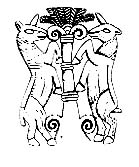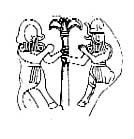
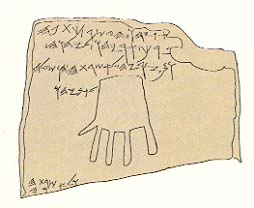
New inscriptions from two different sites have reopened the debate about the meaning of asherah, a term often used in the Bible. Is it—or she—a goddess? Is it a holy place? Or perhaps a sacred tree? Or a pole? Or possibly a grove of trees? All these suggestions have been proposed at one time or another by scholars.
The question is especially intriguing because, as a result of these new inscriptions, the inquiry now arises in connection with the sacred unpronounceable name of Israel’s God, usually written YHWH, or Yahweh.a Whatever an asherah is, Yahweh had one!
The first of these inscriptions came to light, as seems to be the case so often, as a result of an illegal excavation by Bedouin or by Arab farmers. A few months after the Six-Day War of June 1967, when Old and New Jerusalem were reunited, some Iron Age material, including a short Hebrew inscription on limestone cut from a tomb wall, was offered on the Jerusalem antiquities market. All this material, including about 125 pieces of eighth-century B.C. pottery and a collection of iron and bronze implements as well as the inscription, was acquired by Dr. William G. Dever for Hebrew Union College, with which he was then associated. After considerable intrigue, the material was traced to a small Arab village named Khirbet el-Kom, just eight miles west of Hebron in the territory of Judah. There Dever located a group of Iron Age tombs that gave evidence of having been recently robbed on a very large scale. The materials Dever had purchased obviously came from this site. Dever immediately undertook a salvage excavation of the site.
In the course of his excavation, Dever not only located the tomb from which the inscription had been cut, he also found two other Hebrew inscriptions carved on the limestone walls of the tomb-cave. All the inscriptions could be dated on epigraphic groundsb to the eighth century B.C. Two of the three inscriptions are short and simple. One reads as follows: “Belonging to Ophai, the son of Nethanyahu, (is) this tomb-chamber.” The second, written in ink, reads nearly the same: “Belonging to Ophai, the son of Nethanyahu.”
The longest and most interesting inscription, however, is what appeared to Dever to be a four-line inscription carved on a pillar between two tomb chambers. Unfortunately, some of it is very difficult to read because it was incised as a graffitoc in the soft chalky rock of the tomb. Line three’s meaning is especially difficult to determine; most of the letters on this line were incised twice, but the second time the engraver did not scratch them exactly on the same line, so that most of the letters are doubled and the general aspect is very confusing. In 1970, Dever published the inscription together with his reading and interpretation of it,1 recognizing that “line 3 is most difficult.” Although Dever gave what he called a “tentative translation,” he conceded that “perhaps the whole last line [line 3] is to be divided [into words] and understood quite differently.” (The letters are not divided into words but simply run on in a continuous sequence; moreover, since Hebrew is written for the most part without vowels, interpretation can be quite difficult.)
In these circumstances, I decided it would be desirable to attempt my own reading of the inscription, which, after a careful study of the incisions, I published in 1977.2 In general, I was in accord with Dever with respect to much of the inscription, but I disagreed with him significantly in the reading of line 3. By dividing the letters into words differently, I discovered a reference to an asherah. Both Dever and I read Yahweh at the end of line 2, so in my reading this was to become an asherah of Yahweh.
In addition, at the end of the inscription there were some scratchings that Dever did not identify as part of the inscription. He recognized the Hebrew letters
My reading and translation of the inscription is as follows:
1. Uryahu the wealthy man had it written
2. Blessed be Uryahu by Yahweh
3. and by his asherah; from his enemies he saved him!
4. (written) by Onyahu.
5. … and by his asherah
6. … (and by) his (ashe)r(ah)
The words and letters in parentheses are reconstructions not actually in the inscription. In addition, I have changed the position of “by his asherah” in line 3; in the original it appears after “enemies.” I believe that the engraver, working in the dark of the tomb with only an oil lamp for light, made a mistake, perhaps forgetting to carve “by his asherah” at the beginning of the line and then writing it after “from his enemies.”
In any event, the reading of asherah now seems quite certain.d It is confirmed by the undoubted reference to asherah in line 5 and the probable reference in line 6.
When we transpose the reference to asherah in line 3 to the beginning of the line, as I believe we must do, we are able to resurrect what was probably an old popular blessing formula from the middle of the eighth century B.C., the date of this inscription as indicated by an analysis of the letters and spellings. Although this blessing formula—“Blessed by Yahweh and his asherah”—appears only once in the inscription and despite some uncertainty in the transposition, it seemed to me very likely that this formula was extremely common at that time.
It is not hard to imagine the excitement and satisfaction with which I greeted the news—just when my translation was being printed—that another inscription bearing this very same formula had been found in an excavation in Sinai.
In fact, the archaeologists working in Sinai had excavated their inscription shortly before my publication of the Khirbet el-Kom inscription. This Sinai excavation, in 1975 and 1976 at a site known as Kuntillet Ajrud, was directed by Ze’ev Meshel of Tel Aviv University (see “Did Yahweh Have a Consort?” BAR 04:03).3 The site lies about 40 miles south of Kadesh Barnea and about 55 miles northwest of Eilat, almost on the border of the Negev. The major building on the site was apparently a kind of caravansary for travelers and traders. It was perhaps also a guard station protecting the desert crossroads connecting the Nile Delta with Gaza and Eilat. Dozens of crudely painted inscriptions were found on the plastered walls and on large storage jars.
Many questions have been raised about these intriguing and highly important inscriptions from Kuntillet Ajrud, and they have already been the subject of numerous scholarly articles.4 But at least one thing is clear: asherah after Yahweh in a blessing formula is repeated several times. Thus, for example, on one storage jar we find “I bless you by Yahweh of Samaria and by his asherah” (brkt ‘tkm lyhwh s
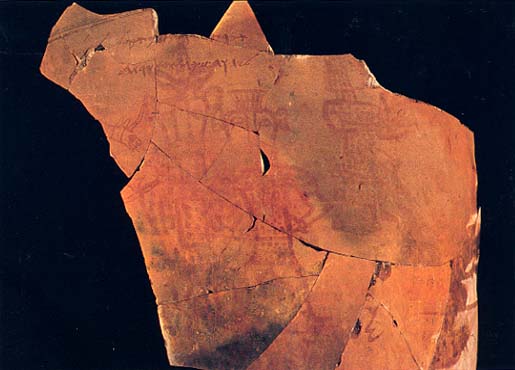
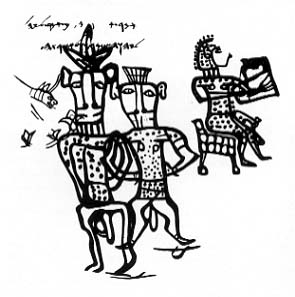
Another reads: “I bless you by Yahweh of Teiman and by his asherah” (brktk lyhwh tmn wl‘s
Similar blessing formulas seem to appear in the Phoenician inscriptions painted on the plaster walls of Kuntillet Ajrud, which, like the Old Hebrew inscriptions on the storage jars, can be dated on paleographical grounds to the first half of the eighth century, about 776–750 B.C.,5 during Jeroboam II’s reign. The mention of “Samaria” and the way the personal names are written with the ending –yw seem to indicate that these Kuntillet Ajrud inscriptions were written by people from the northern kingdom of Israel, rather than the southern kingdom of Judah.
The inscriptions from Kuntillet Ajrud of course strongly reinforce my reading of the inscription from Khirbet el-Kom.
It is now clear that we must confront blessing formulas mentioning Yahweh’s asherah. These blessing formulas were used by people from Judah (as at Khirbet el-Kom) as well as by people from Israel (as at Kuntillet Ajrud) in about the middle of the eighth century B.C., that is, during the period before Hezekiah’s reign (c. 719–699 B.C.) and during the religious reforms associated with his reign.
In understanding these blessing formulas, we must start with the fact that Yahweh had an asherah. The asherah is clearly associated with Yahweh. It is, of course, tempting to conclude that asherah is a goddess—more precisely, Yahweh’s consort. And indeed, this interpretation has been urged by several commentators,6 especially by scholars who are familiar with the texts from Ugarit and are also experts in other ancient non-Hebrew Semitic religions. It is these materials that most strongly suggest that asherah is in fact a goddess.
The famous site of Ugarit, on the Syrian coast, yielded a cache of 14th- to 13th-century B.C. cuneiform tablets that are a primary source for understanding pre-Israelite, Canaanite religion.e Included in the cache are several ritual texts and at least three religious epic myths. Among the many goddesses who appear in the Ugaritic texts is Athirat, the consort of the great god El. Athirat is the Ugaritic linguistic equivalent of Hebrew asherah.f One of Athirat’s epithets is “Athirat-of-the-Sea (atrt ym).” As El’s consort, she is also called “creator (or begetter) of the gods (qny ilm).” The cult of Athirat was especially strong in Late Bronze Age Tyre (15th to 13th centuries B.C.). In one Ugaritic myth, the Story of Keret, we learn of a sanctuary dedicated to “Athirat of the Tyrians.”7
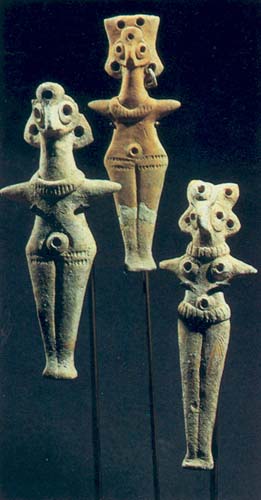
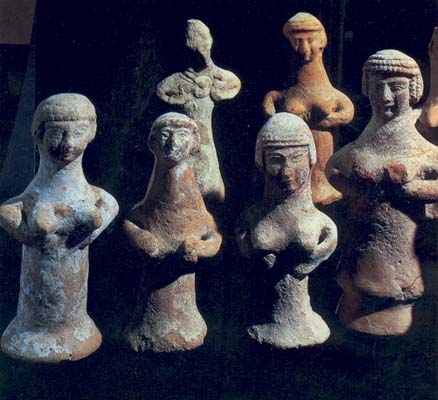
It is well-known that in Israelite religion Yahweh replaced the great god El as Israel’s God. If Yahweh replaced El, it would seem logical to suppose that under Canaanite influence asherah replaced Athirat, and that, at least in the popular religion of ancient Israel if not in the purer form of that religion reflected in the Bible, asherah functioned as the consort or wife of Yahweh.
Moreover, a number of Biblical texts seem consistent with this interpretation. In Judges 3:7, we read that during Joshua’s time (c. second half of the 13th century B.C.), “The Israelites did what was offensive to Yahweh; they ignored Yahweh their God and worshipped Baalim (plural of Baal) and Asherot (plural of asherah).” Here the asherot are worshipped in association with a god.
In 1 Kings 18–19, the prophet Elijah, in the ninth century, asks King Ahab to summon on Mount Carmel “450 prophets of Baal and 400 prophets of Asherah.” Again asherah is associated with a god (Baal); this time the asherah even has prophets, apparently about as many as Baal.
Asherah is again associated with Baal during the religious reform of King Josiah (c. 622 B.C.) when Josiah ordered “the objects made for Baal and Asherah” removed from the Temple and burned (2 Kings 23:4).
In the Iron Age (12th to 6th centuries B.C.) levels of excavations all over Israel, one of the most common finds are small female fertility figurines. We now have hundreds of these figurines.8 Several archaeologists and Biblical scholars have identified these figurines as representations of a goddess Asherah.9
Moreover, on one of the large storage jars (called pithoi) from Kuntillet Ajrud, some commentators believe they see asherah as a goddess depicted in a drawing, standing beside a figure identified as Yahweh.10
Despite what may appear to be the formidable case I have summarized above, I do not believe that asherah is a goddess-consort to Yahweh either in the Khirbet el-Kom inscription or in the Kuntillet Ajrud inscriptions. Neither do I believe that asherah refers to a goddess in the Biblical texts I have cited. Let us look at the evidence more closely.
First, we return to the drawing on the storage jar from Kuntillet Ajrud, which supposedly features asherah standing beside a figure representing Yahweh. The middle figure on the storage jar, in a group of three with two standing on the left and one seated on the right, is clearly the Egyptian god Bes, easily recognized by his arms akimbo and his feathered headdress. Additional study of the figure standing on the left reveals that it too is clearly a depiction of Bes. There is no reason to believe that the left figure is Yahweh or that the middle figure is a depiction of Yahweh’s consort, an asherah.11 In short, there is no figure here that could possibly be Yahweh. This leaves us with the figure of a seated female lyre player on the far right. She is simply a lyre player accompanying the standing figures of Bes. The storage jar does contain an inscription referring to Yahweh’s asherah, but the drawing on the jar in no way suggests that the word asherah as used in the inscription means a goddess or a consort.
Upon careful study, the Ugaritic texts are no more persuasive than the drawing on the storage jar from Kuntillet Ajrud. We are considering whether references to Yahweh’s asherah in the eighth century B.C. are intended to refer to a female consort. In assessing what light is shed on this question by the Ugaritic texts, we must remember that they were written at least 500 years earlier, in a different country (on the northern Syrian coast) and in a different language (Ugaritic). The use of Ugaritic parallels in this instance is probably an example of excessive use of religious comparativism to reach an extreme and invalid conclusion. Phoenician texts of the first millennium, which are much closer in time to our references to Yahweh’s asherah than the Ugaritic texts of the second millennium, make no mention of a goddess asherah.12 Baal is often mentioned in these texts, especially in votive inscriptions and as part of personal names,g but no reference is ever made to his asherah.
This brings us to the Biblical references to Baal and asherah. Without the support of the Ugaritic texts referring to asherah as a goddess and without the depiction of an asherah goddess on the storage jar from Kuntillet Ajrud, there is no reason to interpret asherah in the Biblical references cited above as a goddess. Nor is there any special or peculiar reason to interpret the common fertility figurines of the Iron Age as depictions of a goddess Asherah.
Moreover, a knowledge of Hebrew grammar reveals that there is an insuperable grammatical obstacle to interpreting these Biblical passages as references to the name of a goddess. This argument is not hard to understand, but it does require a little background. In English we use the definite article “the” to make a noun definite or, as the scholars say, determinated. In Hebrew, the prefix ha is used for this purpose. But in Hebrew (as in English), proper names are determinated;13 they do not normally take the prefix ha. You would no more say “the asherah” or ha-asherah if it were the name of a goddess than you would say “the Susie.” (A rare exception is when the Hebrew name is used not as a personal name but as an appellative; that is, when it has become a common noun, for example, when Baal is used to denote not the name of a particular god, but simply lord.) Asherah is used in the Bible, however, with the definite article (“the” or ha-). There are many examples of this, for example, Judges 6:25, 6:26, 6:30 and 1 Kings 16:33. Thus, these Biblical references to asherah preceded by the definite article indicate that asherah is not, in these references, a personal name.
Moreover, personal names in Hebrew never have a pronominal (or pronoun) suffix, such as –y meaning “my.” The new inscriptions from Khirbet el-Kom and Kuntillet Ajrud show that asherah can be constructed with a pronominal (or pronoun) suffix, in this case, –h, meaning “his.”
Thus, it is clear that neither in these Biblical passages nor in the Old Hebrew inscriptions from Khirbet el-Kom and Kuntillet Ajrud is asherah a personal name of a goddess. It is a generic noun referring to something else.
Another possibility is that an asherah is simply a holy “place.” This interpretation is suggested by comparisons with other Semitic languages. In Akkadian, asirtu indicates a holy “place,” a “sanctuary.”14 Cognates from eighth-century B.C. Old Aramaic15 have the same meaning, as do cognates in Middle (roughly 500 B.C.) and Late (third century B.C.) Punic Phoenician.16 On this basis, one prominent scholar has suggested that we understand the Hebrew word asherah as a holy place or sanctuary.17
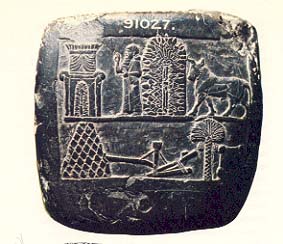
Even though asherah is often associated in the Bible with a sacred place, especially the so-called “high places” or bamot (singular bamah), the context seems to indicate that the asherah is not the high place itself or the whole sanctuary but rather a cultic object which is part of the high place. In short, asherah is more specific.
Let us look more closely at a few of the Biblical references. (There are too many to cite them all.)
Asherot are mentioned most prominently in connection with the two great religious reforms of the Old Testament, the first by King Hezekiah of Judah at the end of the eighth century B.C. and the second by King Josiah of Judah toward the end of the seventh century B.C.
Hezekiah’s reform is described in 2 Kings 18:4:
“He [Hezekiah] abolished the hill-shrines (bamot) and smashed the sacred pillars (massebot) and cut down the asherah. He also broke into pieces the bronze serpent which Moses had made.”
The book of Deuteronomy is usually associated with the Josianic reform of the next century. It was then, many scholars believe, that most of Deuteronomy was written. In this passage from Deuteronomy, the Lord commands the Israelites through Moses:
“You shall not plant a tree as an asherah beside the altar of Yahweh your God that you shall build; you shall not set up a sacred pillar (massebah) which Yahweh your God hates” (Deuteronomy 16:21–22).
In the first quotation above (the one from 2 Kings), asherah is preceded by the definite article “the” (the Hebrew letter he), an indication that asherah is not the personal name of a goddess.
Both these passages make clear that the suppression of Yahweh’s asherah was one of the principal aims of both Hezekiah’s religious reform and Josiah’s.
These passages also reflect the fact that an asherah is a wooden object associated with the cult of the high places (bamot). From other Biblical passages we learn that an asherah can be planted (nt
In rabbinic commentaries as well as in some ancient translations into Greek (like the Septuagint of the third century B.C.) as well as in the King James Version, asherah is translated grove. Others suggest it should be translated as a wooden pole. Either is possible, but I prefer to think of it as a sacred tree or possibly a group of trees, as in a grove. Some commentators who see the term as referring to a sacred pole suggest that this pole was a symbol—or possibly a wooden statue—of a goddess Asherah.18
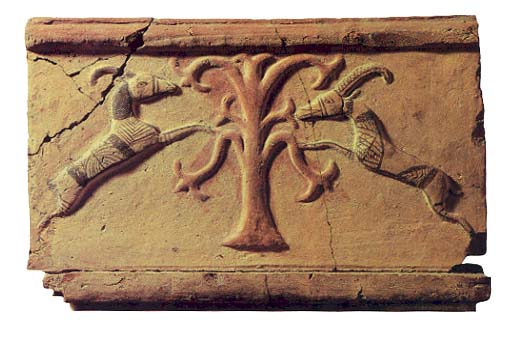
Interpreting asherah as a sacred tree or grove conforms very well with what we know generally about the cultic places of the ancient Near East (Egypt, Mesopotamia and Syria-Palestine). A sacred tree, or grove, or garden is frequently associated with a sanctuary or cult place (see for instance Judith 3:8). The tradition of the sacred tree is found as late as the 19th century A.D. in a few Palestinian villages.
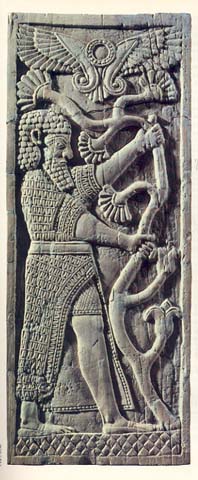
Nevertheless, it must be conceded that the references to asherah associated with Baal could point in the direction of an asherah’s being a goddess. But all the references to asherah in association with Baal are relatively late (in terms of when the Biblical text was actually written down)—that is, beginning in the late eighth century B.C.
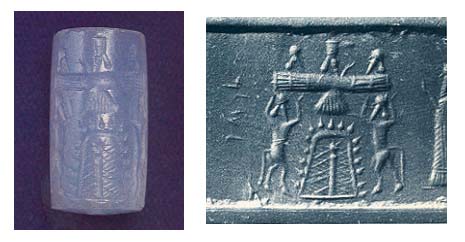
In the late eighth century B.C., about the time of Hezekiah’s religious reformation and his centralization of the cult in Jerusalem (which is why all outlying cult centers were destroyed), we notice the beginnings of some transformation in the attitude toward the asherah. This transformation appears not only in the context of Hezekiah’s religious reformation in the eighth century but also in the context of the religious reformation associated with the writing of the book of Deuteronomy, led by King Josiah, in the late seventh century B.C. The latter occurred, of course, after a certain amount of Israelite backsliding following Hezekiah’s reforms.
During these two major religious reformations, asherot were officially and definitively expelled from Israelite religion. What had been acceptable in the patriarchal age was no longer acceptable. The outlying cult places—the high places (bamot) with their sacred pillars (massebot) and asherot were no longer tolerated. They had to be destroyed. The Bible, especially those passages containing historical accounts attributed to the so-called Deuteronomic historian (that is, to the same tradition that produced the book of Deuteronomy), preserves polemical texts directed against these cult centers scattered about the country.
To argue more effectively against these outlying cult centers, the Biblical polemicist sought to associate them and their constituent parts with the debased Canaanite religion and the cult of Baal. The message to the people of Israel was that they must reject the outlying cult centers, including the asherot, just as they must reject the cult of Baal (and other gods).
The objectification of aspects of the divine and the personification of cultic objects is a common phenomenon in the history of religions.19 We find it, for example, in Ugarit and in Aram.h Among a polytheistic people, such an evolution is unobjectionable. But to people of a monotheistic or monolatrici religion, such an evolution is a very serious threat, raising the specter of an anathema. The eighth-century prophet Hosea inveighs against the high places (bamot), although they were acceptable in the patriarchal age. The prophet tells us that the Lord will destroy the high places; thorns and thistles will then grow on the altars (mizbehot), and the mountains where once these cult places stood will humiliate the people (Hosea 10:8).
Amos, from about the same period, prophesies that for the transgressions of the people, the Lord will destroy the altars (mizbehot) of Beth-el and cut off their horns (Amos 3:14); the high places (bamot) of Isaac will be desolate (Amos 7:9).
We may assume that the asherot were similarly condemned (Deuteronomy 16:21–22). The prophets were fearful that these cultic objects might become sacred in themselves, as a god, and so become rivals of Yahweh.
The recent inscriptions from Khirbet el-Kom and Kuntillet Ajrud help illuminate the prophet’s messages. They help us understand why the asherah was rejected from official Israelite religion at the end of the eighth century B.C. In these inscriptions, asherah is still a generic name, as shown by the pronominal (or pronoun) suffix, but it is on the way to being personified, as reflected in the way the asherah is associated with Yahweh in blessing. In a more subtle psychological or theological way, we are witnessing a kind of birth of a hypostasis in which the essence of the divine is bound to a cultic object; that is, an aspect of the divine is becoming concretized or reified—and may soon rival God himself.
Thus these recently recovered inscriptions do more than give us direct evidence of an eighth-century blessing formula; they also illuminate an important chapter in the history of Israelite religion. They help us to understand the nature of popular Israelite religion before Hezekiah’s reforms. They also help us to understand why the prophets and kings (or at least some of them) sought to suppress the traditional local sanctuaries, which very probably contained sacred trees known as asherot.
MLA Citation
Footnotes
In Hebrew, the name consists of the four letters YHWH, yod, he, waw, he, and is known as the Tetragrammaton. In many English translations of the Bible, YHWH is translated LORD. Elohim, by contrast, is translated as the generic name God; YHWH, however, is the name of Israel’s God. No one is sure how these four Hebrew letters were pronounced (in Biblical Hebrew, the vowels are not generally indicated), but by scholarly convention, the name is vocalized as Yahweh.
This has been confirmed by two other epigraphists, J. R. Engle, Pillar Figurines of Iron Age Israel and Ashérah-Ashérim, Diss. 1979 (Ann Arbor, 1981), p. 82, and K. Jaros
See “An Appreciation of Claude Frederic-Armand Schaeffer-Forrer (1898–1982),” BAR 09:05, by James M. Robinson; “The Tablets from Ugarit and Their Importance for Biblical Studies,” BAR 09:05, by Peter C. Craigie; and “The Last Days of Ugarit,” BAR 09:05, by Claude F. A. Schaeffer, translated by Michael D. Coogan.
The Ugaritic t (th) is equivalent to the Hebrew s (sh), and the Ugaritic feminine ending –t is equivalent to the Hebrew –h.
As in ’dnb‘l, “Adonibaal,” ‘zrb‘l, “Azorbaal,”/“Azdrubal,” b‘lhn’ “Baalhano.” F. L. Benz, Personal Names in the Phoenician and Punic Inscriptions (Rome, 1972), pp. 280, 288–290.
See the Ugaritic goddesses “Qudshu” (qds, etyrnologically “sanctuary”) and “Athirat” (atrt, etymologically “[holy] place”) and the Aramaic god “Bethel” (byt-’l, etymologically “house of god,” “temple”).
Endnotes
W. G. Dever, “Iron Age Epigraphic Material from the Area of Khirbet el-Kom,” Hebrew Union College Annual 40/41 (1969–1970), pp. 139–204.
A. Lemaire, “Les inscriptions de Khirbet el-Qom et l’asherah de YHWH,” Revue Biblique 84 (1977), pp. 595–608.
See also Ze’ev Meshel, Kuntillet ‘Ajrud, A Religious Centre from the Time of the Judaean Monarchy on the Border of Sinai, Israel Museum Catalog 175 (Jerusalem, 1978).
Cf. J. Naveh, “Graffiti and Dedications,” Bulletin of the American Schools of Oriental Research 235 (1979), pp. 27–30; J. R. Engle, Pillar Figurines of Iron Age Israel and Ashérah-Ashérim, Diss. 1979 (Ann Arbor, 1981); M. Weinfeld, “A Sacred Site of the Monarchic Period,” Shnaton 4 (1980), pp. 280–284 (Hebrew); D. A. Chase, “A Note on an Inscription from Kuntillet ‘Ajrud,” Bulletin of the American Schools of Oriental Research 246 (1982), pp. 63–67; J. A. Emerton, “New Light on Israelite Religion The Implications of the Inscriptions from Kuntillat ‘Ajrud,” Zeitschrift für die alttestamentliche Wissenschaft 94 (1982), p. 220; P. J. King, “The Contribution of Archaeology to Biblical Studies,” Catholic Biblical Quarterly 45 (1983), pp. 1–16, especially 12–13; A. Lemaire, “Abécédaires et exercices d’écolier en épigraphie nord-ouest sémitique,” Journal Asiatique (1978), p. 221–235; id., Les écoles et la formation de la Bible dans l’ancien Israel (Orbis biblicus et orientalis [a series]) 39 (Fribourg, 1981), pp. 25–32.
A. Lemaire, “Date et origine des inscriptions hébräiques et phéniciennes de Kuntillet ‘Ajrud,” to be published in Studi Epigrafici e Linguistici 1, 1984.
Cf. R. Patai, “The Goddess Asherah,” Journal of Near Eastern Studies 24 (1965), pp. 37–52; id., The Hebrew Goddess (1967), pp. 29–52.
J. B. Pritchard, Palestinian Figurines in Relation to Certain Goddesses Known through Literature (American Oriental Series 24: London, 1943); K. M. Kenyon, Jerusalem (London, 1967), pp. 101–103; T. A. Holland, “A Study of Palestinian Iron Age Baked Clay Figurines … ”, Levant 9 (1977), pp. 121–155.
Pirhiya Beck, “The Drawings from Horvat Teiman (Kuntillet ‘Ajrud),” Tel Aviv 9 (1982), pp. 29–31.
None of the references proposed by J. R. Engle (Pillar Figurines) is certain; more probably, each one is to be explained otherwise; cf., for instance, Z. Zevit, Israel Exploration Journal 27 (1977), p. 115.
Sfiré I B 11, ’s
Pyrgi 1, 1, ’s
E. Lipinski, “The Goddess Atirat in Ancient Arabia, in Babylon and in Ugarit,” Orientalia Lovaniensia Periodica 3 (1972), pp. 101–119.
W. L. Reed, The Nature and Function of the Asherah in Israelite Religion According to Literary and Archaeological Evidence, Diss. 1942 (Ann Arbor, 1982); T. Yamashita, The Goddess Asherah, Diss. 1963 (Ann Arbor, 1982); A. L. Perlman, Asherah and Astarte in the Old Testament and Ugaritic Literatures, Diss. 1978 (Ann Arbor, 1979).


